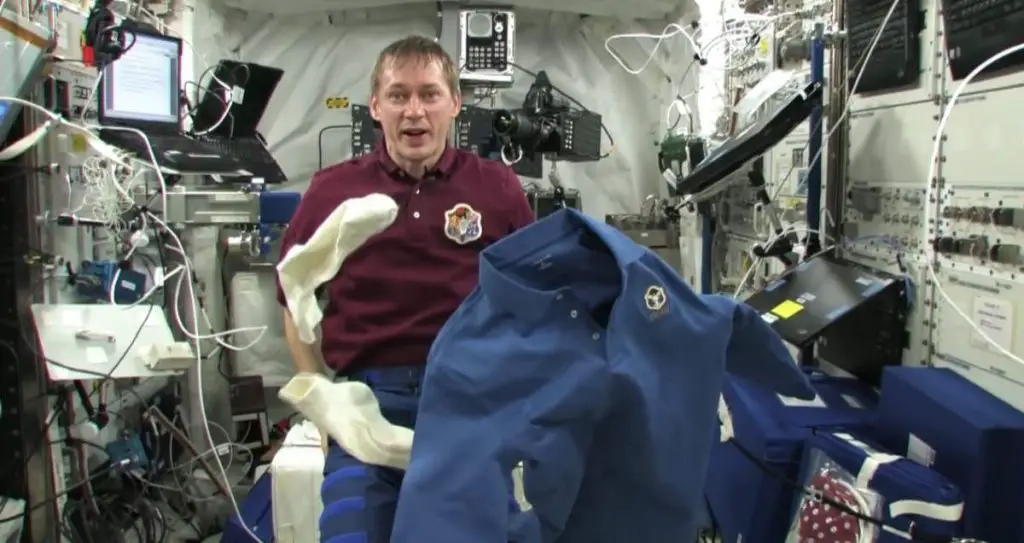How do astronauts wash their clothes in space? Well, the answer is simple: they don’t. It may be weird, but we don’t have a way or technology safe enough to clean laundry in the microgravity environment of space.
Why astronauts don’t wash clothes in space?
Astronauts aboard the International Space Station can take showers. If other hygiene activities like showering have been successfully adapted for life in space, why not laundry?
In his article titled “Socks, The Final Frontier” (published on the Universe Today website), Seth Lockman, Communications Director at bluShift Aerospace explains:
“In the microgravity environment of space, just about every single aspect of how we do our laundry here on Earth becomes a deadly hazard with a single point of failure. All that sudsy water, heat cycling, spinning mass, and even the buildup of static electricity, lint, or fumes could compromise a mission or even cost lives.”
But can’t astronauts use waterless cleaning methods? Lockman answers:
“Fluid-less options like vacuum exposure, ultraviolet, and microwaves have been found to only half work. While they kill many bacteria, they can have trouble penetrating biofilms and do not remove the bacteria’s waste products or physical remains – which is what causes the malodor of used clothing.”
What do astronauts do, instead?
For short-duration missions, like Apollo missions or Space Shuttle missions, for example, washing clothes simply isn’t necessary. Astronauts just pack enough clothes for these one or two-week missions.
What about longer missions, for example, regular six-month missions aboard the International Space Station?
Answering the question “How do astronauts wash clothes in space?”, Belgian ESA astronaut Frank de Winne explains why astronauts don’t wash clothes in space and what they do instead:
“We don’t wash our clothes in space. We don’t have a washing machine here. It would use a lot of water, and water is very scarce in space.”
“We recycle our water and we only use it to drink, or to wash [taking a shower].”
“Therefore, we just take a stack of clothes with us, and when they get dirty, they get back to the Earth [with resupply missions].”
“Of course, we don’t have a lot of clothes. If you would have fresh clothing or new clothing every day, this would mean a lot of mass (see notes 1) that we need to take up [into Earth’s orbit].”
“Instead, we reuse clothing an awful lot. For example, we wear one shirt for a month. Or, we use the same pair of socks for a week.”
“So, we don’t wash our clothes in space, we change them from time to time.”
Experiments on washing clothes in space
There are experiments, though, because for some deep-space missions resupply may not be an option (for example, a mission to Mars).
Seth Lockman gives examples to them:
Advanced Microgravity Compatible Integrated Laundry System (AMCILS) Development
Perhaps the earliest practical attempt at a microgravity washing machine is the Advanced Microgravity Compatible Integrated Laundry System (AMCILS), conceptualized by UMPQUA Research Company in the 1980s. This washer-dryer combo notably relied on water jets to agitate the clothes and microwaves to dry them. As of 2017, a prototype completed parabolic zero-G testing.
Space washing machine concept
In 2021 six teams of summer interns at NASA’s Glenn Research Center each spent a week designing a space washing machine. The overall Best Design award went to a team that used a central corkscrew rather than a drum, to soak and agitate the laundry. NASA has hinted that the program may grow in the coming years, taking on the scale of programs like the Human Exploration Rover Challenge.
P&G Telescience Investigation of Detergent Experiments (PGTIDE)
In August of 2020 parties from NASA and Tide’s parent company Proctor and Gamble jointly signed a Space Act Agreement to develop low-toxicity detergent use in microgravity, compatible with the water reclamation system on the ISS. The result of the Agreement is P&G Telescience Investigation of Detergent Experiments (PGTIDE), to date the most rigorously flight-tested space laundry experiment.
The PGTIDE experiment consists of three distinct efforts.
- Launching in December of 2021, Objective 1’s payload is a sample of Tide Infinity, the experimental detergent. In the O-1 experiment Astronauts on the ISS produced a variety of stains on a variety of fabrics and tested the effectiveness of Tide Infinity at removing them. The experiment was repeated on the ground to control for the effect of microgravity on the detergent. Throughout this phase, scientists monitored the stability of Infinity during months of microgravity and the higher ambient radiation levels of space.
- Objective 2 payloads, including Tide To Go Pens and Wipes and Tide Rescue Spray, launched to the ISS in July of this year. The main O-2 experiment will have astronauts treat a sample group of pre-stained fabrics from Earth and a group of fabrics they stain in flight. The dependent variable will be the stain removal efficacy of unmodified To Go products in space over the course of several months.
- Lastly, NASA and Tide researchers may design a combo washer-dryer that uses the Infinity detergent with as little power and water as possible. The washer-dryer would be intended for use in the low-gravity environment of a Moon or Mars colony, so unfortunately we may still be years away from true deep space washing.

Notes
- Sending mass into orbit is still very expensive, even with reusable rockets.
Sources
- “Socks, The Final Frontier” on the Universe Today website: “It’s strange but true, right now we don’t have a way to clean laundry in space.”
- Moon Landings: All-Time List [1966-2025] - February 2, 2025
- What Is Max-Q and Why Is It Important During Rocket Launches? - January 16, 2025
- Top 10 Tallest Rockets Ever Launched [2025 Update] - January 16, 2025
